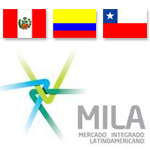On November 22, the stock exchanges of Lima, Peru (the BVL); Colombia (the BVC); and Santiago, Chile (the BCS) will make their shares available to investors in all three countries. The first stage in the integration will facilitate technological access to the local market for foreign intermediaries. The exchanges will remain separate legal entities that function and operate independently.
The integration provides investors with a route to diversification; the markets individually are heavy with issuers from particular industries. Mining companies represent more than half (53%) of the market capitalization of the Peruvian market, according to the Lima-based exchange. In Colombia, the industrial sector provides 78% of market capitalization. And in Santiago, the service sector weighs in with 32%.
From the viewpoint of share issuers, Piedrahita says, integration “would make it easier to enter capital markets, which would translate into lower costs for financing, and better receptivity to public share offerings.”
Robert Tornabell, professor of finance at the ESADE business school in Spain, also believes that integration will have advantages for publicly traded companies and investors. “The companies will have the opportunity to attract a greater volume of capital and compete among themselves with new issues of shares in the stock markets.” Meanwhile, “investors will be able to put their savings into different countries apart from their own, and they will be able to know and control them much better.”
Still, integration can propel Latin America toward much more ambitious goals. “The big step that could be achieved is to go from integration of the stock markets to integration of these countries’ economies. For this to happen, the first step would be integration of trade among the three countries, through a much stronger free-trade agreement,” Piedrahita says.



